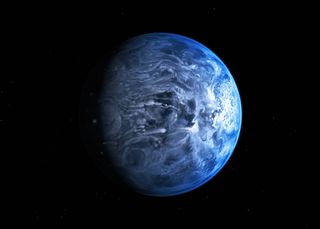
The alien planet HD 189733b is a beautiful blue dot in a sea of inky blackness, just like Earth. But that's where the similarities between the two worlds end.
For starters, HD 189733b is much bigger and hotter than Earth; it's about the size of Jupiter and zips around its host star in just 2.2 Earth days. That orbit is so close that the exoplanet is probably tidally locked, always showing one face to its star, just as the moon always shows one face (the near side) to Earth.
And then there's the weather. The winds on HD 189733b (which lies about 63 light-years from Earth, in the constellation Vulpecula) blow at up to 5,400 mph (8,700 km/h) — about seven times the speed of sound. And if that's not crazy enough for you, scientists think the rain on this world is made not of water, but of molten glass.
Why, then, does this bizarre planet appear so superficially Earth-like? It's just a coincidence, scientists said.
"The cobalt blue color comes not from the reflection of a tropical ocean, as on Earth, but rather a hazy, blow-torched atmosphere containing high clouds laced with silicate particles," NASA officials wrote in a statement.
There may be a lot of ocean-free blue planets out there. Indeed, scientists know of two in Earth's own solar system: Uranus and Neptune. The upper atmospheres of both of these "ice giants" contain methane, which reflects blue wavelengths of sunlight back into space.
HD 189733b was discovered in 2005, and scientists figured out its color in 2013 using NASA's Hubble Space Telescope and other instruments. The exoplanet is one of six highlighted in NASA's "Galaxy of Horrors," a special Halloween gallery that the space agency put together this year. You can check out the Galaxy of Horrors here: https://exoplanets.nasa.gov/alien-worlds/galaxy-of-horrors/
Get the Space.com Newsletter
Breaking space news, the latest updates on rocket launches, skywatching events and more!
Follow Mike Wall on Twitter @michaeldwall and Google+. Follow us @Spacedotcom, Facebook or Google+. Originally published on Space.com.
Join our Space Forums to keep talking space on the latest missions, night sky and more! And if you have a news tip, correction or comment, let us know at: community@space.com.

Michael Wall is a Senior Space Writer with Space.com and joined the team in 2010. He primarily covers exoplanets, spaceflight and military space, but has been known to dabble in the space art beat. His book about the search for alien life, "Out There," was published on Nov. 13, 2018. Before becoming a science writer, Michael worked as a herpetologist and wildlife biologist. He has a Ph.D. in evolutionary biology from the University of Sydney, Australia, a bachelor's degree from the University of Arizona, and a graduate certificate in science writing from the University of California, Santa Cruz. To find out what his latest project is, you can follow Michael on Twitter.
